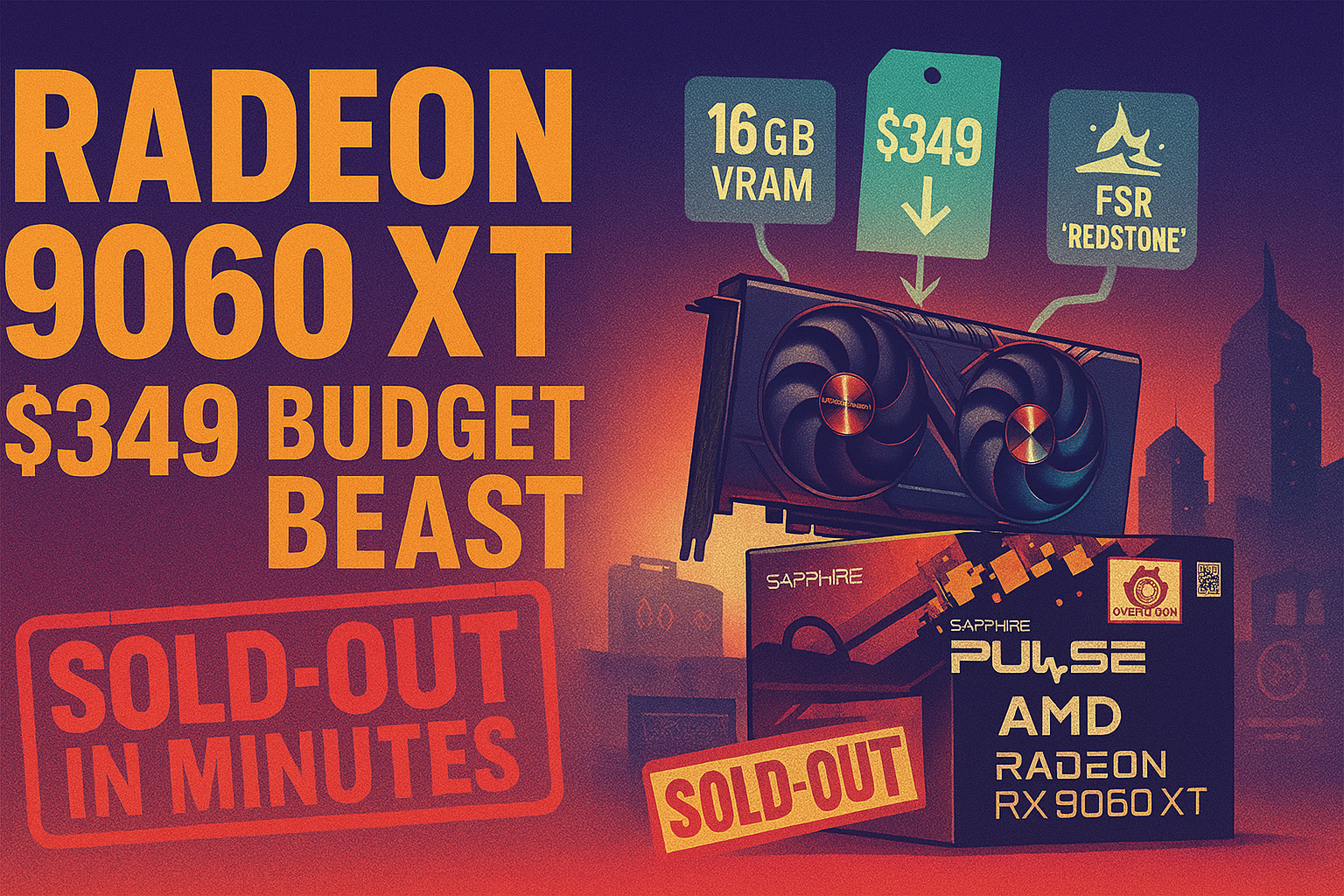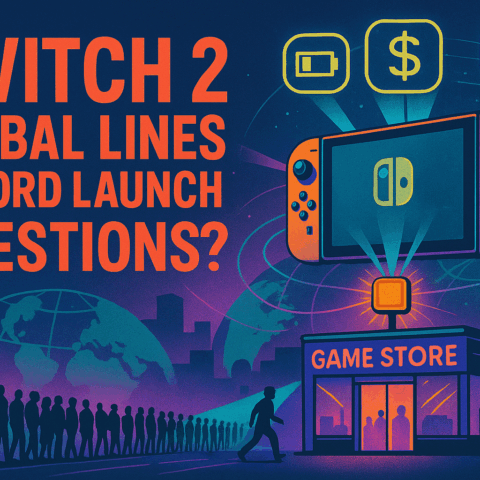The AMD Radeon RX 9060 XT launched on June 5, 2025, Tom’s Hardware with the 16GB model priced at $349 Tom’s Hardware +4 selling out within hours across major retailers, Tom’s Hardware +2 marking a rare success story in GPU availability. Amd +3 The card delivers performance within 3-5% of NVIDIA’s RTX 5060 Ti while costing $80 less, Tom’s Hardware +4 positioning itself as the most compelling budget GPU of 2025. Tom’s Hardware +2 Built on AMD’s new RDNA 4 architecture with the Navi 44 chip, it offers 32 compute units, 2,048 stream processors, and boost clocks up to 3.13 GHz Engadget +6 – AMD’s highest for the RX 9000 series. TechPowerUp +4 The launch represents AMD’s strategic shift toward aggressive value positioning in the mainstream market, abandoning high-end competition to focus on the volume segment where 90% of gamers purchase their GPUs. NeoGAF
Launch details reveal strategic positioning
AMD announced the RX 9060 XT at Computex 2025 on May 20, with availability beginning June 5 through board partners exclusively – no reference design exists. Tom’s Hardware +4 The card comes in two variants: an 8GB model at $299 and a 16GB model at $349, Tom’s Hardware +5 though market reaction heavily favored the latter. Amd +3 Built on TSMC’s 4nm N4P process, the 153mm² die contains 29.7 billion transistors, TechPowerUp +3 representing AMD’s most efficient mainstream GPU design to date. TechPowerUp
The specifications include a 128-bit memory interface delivering 320 GB/s bandwidth through 20.1 Gbps GDDR6 memory, Tom’s HardwareTechPowerUp paired with 32MB of Infinity Cache. TechPowerUp +3 Power consumption sits at 150W for the 8GB model and 182W for the 16GB variant, requiring only a single 8-pin PCIe power connector. TechPowerUp +4 AMD upgraded the interface to full PCIe 5.0 x16 support, Tom’s Hardware addressing previous criticisms of x8 limitations on budget cards. TechPowerUp +5 Display outputs were reduced to one HDMI 2.1b and two DisplayPort 2.1a ports, GearinstockTechPowerUp a cost-saving measure that still covers most use cases. TechPowerUpwww.guru3d.com
Market reaction splits between instant sellouts and lingering stock
The launch defied typical 2025 GPU market trends by maintaining reasonable availability and pricing. Tom’s Hardware Unlike the RX 9070 series that saw immediate scalping with 100% markups, Tom’s Hardware the RX 9060 XT experienced minimal secondary market activity. The 16GB model sold out quickly at most retailers, Tom’s Hardware stabilizing at $389-390 (about $40 over MSRP), while 8GB models remained widely available at the $299 MSRP. Tom’s Hardware +3
UK retailer Overclockers UK reported having over 2,000 units for launch day, creating what they called a “castle” of GPU boxes VideocardzOC3D – a stark contrast to typical paper launches. MicroCenter physical stores in the US showed consistent stock levels, with the Duluth, Georgia location reporting 14 units available days after launch. Tom’s Hardware International availability proved even stronger, with European retailers maintaining closer-to-MSRP pricing after VAT considerations. Tom’s Hardware
Consumer sentiment strongly favored the 16GB variant, viewing the extra $50 as worthwhile future-proofing. Tom’s Hardware The gaming community largely dismissed the 8GB model as insufficient for 2025 requirements, Techspot particularly after AMD’s Frank Azor controversially stated that “the majority of gamers don’t need more than 8GB.” Tom’s Hardware +2 This comment sparked significant backlash, though it didn’t impact sales of the 16GB model.
Performance benchmarks position card as genuine RTX 5060 Ti competitor
Independent testing revealed the RX 9060 XT 16GB delivers 111% of RTX 5060 performance at 1080p and 115% at 1440p, while trailing the RTX 5060 Ti by only 3-5% in most scenarios. TechPowerUp +2 The card essentially matches the previous generation RX 7700 XT’s performance TechPowerUp while consuming less power and costing significantly less. Tom’s Hardware
At 1080p ultra settings, the card averages 187 FPS across a 10-game test suite, Tom’s Hardware with standout results including 331 FPS in Counter-Strike 2, TechSpot 254 FPS in Call of Duty: Warzone with FSR 4 enabled, Engadget and 114 FPS in Cyberpunk 2077. Tom’s Hardware +2 Moving to 1440p, performance remains strong with a 134 FPS average, Tom’s Hardware including 90 FPS in Cyberpunk 2077 PC GuideEngadget and 101 FPS in God of War Ragnarök. Tom’s Hardware +2 The card can handle 4K gaming in less demanding titles but requires upscaling for modern AAA games at this resolution.
Ray tracing performance shows AMD’s most significant generational improvement, with the company claiming 100% better RT performance over RDNA 3. TechPowerUp +4 In practice, the RX 9060 XT achieves 47 FPS in Cyberpunk 2077 with RT Ultra at 1080p, nearly matching the RTX 5060’s 46 FPS. EngadgetTweakTown However, NVIDIA maintains an 8-14% advantage in most ray-traced scenarios, particularly when DLSS is factored in.
Target audience focuses on budget-conscious 1080p and 1440p gamers
AMD explicitly targeted the RX 9060 XT at mainstream gamers, acknowledging that 55.27% of Steam users still game at 1080p according to the latest hardware survey. PC Gamer +2 The 16GB variant appeals to those seeking longevity, while the 8GB model targets esports and competitive gaming where VRAM requirements remain modest.
The card’s positioning reflects AMD’s “gamer-first” strategy articulated by David McAfee, prioritizing “performance in the areas that gamers care about most” PC Gamer rather than chasing high-end benchmarks. Substack At $349, the 16GB model offers 19% better value than the RTX 5060 Ti 16GB priced at $430, Videocardz +2 calculated as price per frame delivered. Videocardz +5 This aggressive pricing forced NVIDIA to defend its premium, particularly given AMD’s generous VRAM allocation.
Entry-level PC builders benefit from the full PCIe 5.0 x16 interface, avoiding the bandwidth limitations of competing x8 cards. Tom’s HardwarePCGamesN The single 8-pin power requirement and 500W PSU recommendation also reduce system upgrade costs for those moving from older graphics cards. PCGamesN
Direct NVIDIA comparison reveals strategic advantages
Against the RTX 5060 at $299, the RX 9060 XT 16GB’s extra $50 delivers 11-15% better performance plus double the VRAM. TechPowerUp +3 The RTX 5060 Ti 8GB at $380 costs more while offering half the memory, TechPowerUp making it vulnerable in VRAM-intensive scenarios despite slight performance advantages in pure rasterization.
The most relevant comparison comes against the RTX 5060 Ti 16GB at $430. Here, AMD delivers 95-97% of the performance for 81% of the price, representing a 15% improvement in performance per dollar. Tom’s Hardware +6 NVIDIA maintains advantages in ray tracing performance, DLSS ecosystem maturity with 125+ supported games versus 60+ for FSR 4, and multi-frame generation capabilities. EngadgetTom’s Hardware However, AMD’s value proposition proves compelling for budget-focused buyers prioritizing raw performance and VRAM capacity over bleeding-edge features.
Real-world gaming delivers on marketing promises
User feedback confirms the RX 9060 XT 16GB performs as advertised, with owners reporting smooth 1080p ultra and 1440p high gaming experiences. Engadget Popular titles like Call of Duty: Black Ops 6 show the AMD card outperforming the RTX 5060 Ti by 32%, TechSpot while maintaining competitive frame rates in demanding games like Starfield (89 FPS at 1080p high). TechSpot
FSR 4’s AI-powered upscaling, exclusive to RDNA 4 initially, provides significant performance boosts where supported. TechPowerUp +3 Call of Duty: Warzone jumps from 174 to 254 FPS with FSR 4 and frame generation enabled, Engadget while Space Marine 2 improves from 71 to 90 FPS. EngadgetTweakTown The technology’s image quality improvements over FSR 3.1 help close the gap with NVIDIA’s DLSS, TechPowerUpTechPowerUp though game support remains more limited.
Thermal performance impresses across all tested models, with load temperatures ranging from 54-75°C depending on the cooler design. TechPowerUp +3 Power consumption stays within the advertised 180W envelope, and most cards operate quietly even under sustained gaming loads. No instances of thermal throttling were reported in professional reviews.
Availability challenges concentrate on 16GB variant
While the 8GB model remains readily available at MSRP, the 16GB variant faces periodic stock shortages. Tom’s HardwareTomshardware Major US retailers like Newegg show the 16GB model at $389 when in stock, representing a $40 premium over MSRP. Tom’s Hardware +2 Best Buy employs a drip-feed strategy, releasing small batches throughout the day, while Amazon’s stock arrives sporadically. TomsguideTom’s Hardware
Physical MicroCenter stores offer the best availability for those with local access, often maintaining MSRP pricing on 16GB models. Tom’s Hardware International buyers face varying situations, with UK and European markets showing better stock levels but higher prices after VAT. Asian markets received early stock allocations, suggesting AMD prioritized global distribution over US concentration. Tom’s Hardware
Board partner models from ASUS, Sapphire, PowerColor, and others range from basic dual-fan designs to premium triple-fan configurations. Videocardz +5 Factory overclocked variants command $20-40 premiums but deliver boost clocks exceeding 3.3 GHz, Tom’s Hardware with some models reaching 3.47 GHz. The lack of reference design means pricing varies significantly between manufacturers and regions. PC GamerVideocardz
AMD’s strategic pivot emphasizes volume over margins
The RX 9060 XT embodies AMD’s strategic shift announced at Computex 2025, where executives confirmed abandoning high-end GPU competition to focus on the mainstream market. Tom’s HardwareAMD Frank Azor stated AMD wants to be “as aggressive as possible” on pricing, recognizing that “90% of the gaming market is anywhere between $300-$1000.” PC GamerNeoGAF
This approach reflects AMD’s broader business priorities, with gaming GPU revenue declining 59% year-over-year to $563 million in Q4 2024 while data center AI revenue exceeded $5 billion. The Motley FoolNasdaq By targeting volume in the mainstream segment rather than chasing high-margin flagship products, AMD aims to rebuild market share lost to NVIDIA’s 90% dominance.
The company’s RDNA 4 architecture focuses on efficiency improvements and cost optimization rather than absolute performance leadership. TechPowerUp +2 Manufacturing on TSMC’s 4nm process with a relatively small 199mm² die helps AMD maintain competitive pricing while delivering meaningful generational improvements in ray tracing and AI acceleration. TechPowerUp +3
Expert consensus praises value while noting limitations
Professional reviewers universally recommend the RX 9060 XT 16GB at its $349 MSRP, with Hardware Unboxed calling it “one you might even want to pre-order.” TechSpot PC Gamer named it “the budget card to beat right now,” while GamersNexus praised AMD’s transparency in review sampling compared to NVIDIA’s selective approach. PC GamerTom’s Hardware
Common criticisms focus on the 8GB variant’s inadequacy for 2025 gaming, Tom’s Hardware the persistent ray tracing performance gap versus NVIDIA, and concerns about long-term driver support given AMD’s reduced GPU engineering resources. Tom’s Hardware +3 The limited game support for FSR 4 at launch (60+ titles) compared to DLSS’s mature ecosystem also draws mentions, Engadget though reviewers expect rapid adoption growth. Engadget
Industry analysts view the card as a potential catalyst for increased competition in the budget segment, particularly with Intel’s Arc Battlemage series adding further pressure. PCViewedPC Gamer The success of the 16GB model at $349 may force industry-wide reconsideration of VRAM allocations, potentially establishing 16GB as the new mainstream standard by 2026.
Future outlook suggests continued mainstream focus
AMD’s roadmap indicates continued emphasis on the volume segment through 2025-2026. The upcoming RX 9060 (non-XT) will likely target the sub-$250 market, while RDNA 5 architecture development focuses on returning to high-end competition in late 2025 or early 2026. FSR Redstone, announced for H2 2025, promises further AI upscaling improvements. Tom’s Hardware +2
Market dynamics favor AMD’s strategy, with the gaming GPU segment projected to grow at 21.4% CAGR through 2029. MarketresearchfutureTechnavio Budget-conscious buyers increasingly prioritize value over absolute performance, particularly as game requirements plateau and upscaling technologies mature. The three-way competition between AMD, NVIDIA, and Intel should benefit consumers through aggressive pricing and accelerated innovation. Tom’s Hardware
Long-term success depends on AMD maintaining MSRP discipline through retail channels, expanding FSR 4 game support to match DLSS adoption, and executing consistent driver updates despite reduced engineering resources. PC Gamer The company must also navigate potential tariff impacts and TSMC wafer pricing pressures that could affect future product positioning.
Conclusion
The AMD Radeon RX 9060 XT 16GB at $349 represents the most compelling budget graphics card of 2025, delivering near-RTX 5060 Ti performance for significantly less money while providing future-proofing through generous VRAM allocation. Engadget +7 Its instant sellout demonstrates strong market demand for value-focused GPUs that prioritize practical gaming performance over premium features. Tom’s HardwareTomshardware While the 8GB variant deserves criticism for perpetuating outdated specifications, the 16GB model succeeds in forcing meaningful competition in the mainstream segment. Tom’s Hardware +3 For budget-conscious gamers seeking capable 1080p and 1440p performance with headroom for future titles, the RX 9060 XT 16GB stands as the clear choice Engadget – if you can find it at MSRP.








![Meta's $300 million gamble reshapes the AI talent wars Meta has launched the most aggressive talent acquisition campaign in technology history, offering individual compensation packages up to $300 million over four years to elite AI researchers. CNBC +7 This unprecedented strategy, coupled with $60-65 billion in infrastructure investments for 2025, represents Mark Zuckerberg's all-in bet to transform Meta from an AI follower into the leader in the race toward superintelligence. Data Center Dynamics +5 The campaign has successfully recruited dozens of top researchers from OpenAI, Google DeepMind, and Apple, while fundamentally disrupting compensation norms across the entire AI industry and raising critical questions about talent concentration and the future of AI development. CNBC +8 The $300 million figure decoded: Individual packages, not aggregate spending The widely reported "$300 million AI brain drain" figure represents individual compensation packages for elite AI researchers over four-year periods, not Meta's total spending on talent acquisition. Gizmodo +3 According to Fortune's July 2025 reporting, "Top-tier AI researchers at Meta are reportedly being offered total compensation packages of up to $300 million over four years, with some initial year earnings exceeding $100 million." Fortune Yahoo Finance These packages primarily consist of restricted stock units (RSUs) with immediate vesting, rather than traditional signing bonuses, as Meta CTO Andrew Bosworth clarified: "the actual terms of the offer wasn't a sign-on bonus. It's all these different things." CNBC +2 The compensation structure includes base salaries up to $480,000 for software engineers and $440,000 for research engineers, Fortune supplemented by massive equity grants and performance bonuses. Fortune SmythOS Specific examples include Ruoming Pang from Apple receiving $200+ million over several years Fortune and Alexandr Wang from Scale AI receiving $100+ million as part of Meta's $14.3 billion investment in Scale AI. Fortune +3 OpenAI CEO Sam Altman confirmed these figures on the "Uncapped" podcast, stating Meta made "giant offers to a lot of people on our team, you know, like $100 million signing bonuses, more than that (in) compensation per year." CNBC +6 This compensation strategy emerged after Meta's Llama 4 model underperformed expectations in April 2025, prompting Zuckerberg to take personal control of recruitment. CNBC +3 The CEO maintains a "literal list" of 50-100 elite AI professionals he's targeting, making direct phone calls to recruit them. Fortune +5 While not every hire receives nine-figure packages—typical offers range from $10-18 million annually—the peak compensation levels have redefined industry standards and forced competitors to dramatically increase their retention spending. TechCrunch Meta raids the AI elite: Key acquisitions from competitors Meta's talent acquisition campaign has systematically targeted the architects of competitors' most successful AI models, with particular focus on researchers with expertise in reasoning models, multimodal AI, and foundation model training. SmythOS Fortune The company has successfully recruited 11+ researchers from OpenAI, including several co-creators of ChatGPT and the o-series reasoning models. South China Morning Post +4 Notable acquisitions include Shengjia Zhao, named Chief Scientist of Meta Superintelligence Labs in July 2025, who co-created ChatGPT, GPT-4, and all mini models; CNN Trapit Bansal, a key contributor to OpenAI's o1 reasoning model who pioneered reinforcement learning approaches; TechCrunch TechCrunch and Hongyu Ren, co-creator of GPT-4o, o1-mini, and o3. CNBC +2 From Google DeepMind, Meta secured Jack Rae, the pre-training tech lead for Gemini who also led development of Gopher and Chinchilla; Pei Sun, who led post-training, coding, and reasoning for Gemini after creating Waymo's perception models; Fortune CNBC and multiple other Gemini contributors. CNBC Silicon UK The Apple raid centered on Ruoming Pang, head of Apple's AI foundation models team who led Apple Intelligence development, along with three senior team members including distinguished engineer Tom Gunter. MacDailyNews +4 These acquisitions follow a clear strategic pattern: Meta is targeting researchers with proven expertise in areas where it has fallen behind, particularly reasoning models and multimodal AI. SmythOS The recruits often move as cohesive teams—for instance, the OpenAI Zurich office researchers Lucas Beyer, Alexander Kolesnikov, and Xiaohua Zhai all joined Meta together. TechCrunch TechCrunch This team-based approach accelerates Meta's ability to replicate successful research methodologies while disrupting competitors' ongoing projects. The talent flow has created significant disruption at source companies. OpenAI's Chief Research Officer Mark Chen described the exodus in an internal memo: "I feel a visceral feeling right now, as if someone has broken into our home and stolen something." Yahoo! +2 Apple's AI strategy faced major setbacks after losing its foundation models leadership, forcing a reorganization under Craig Federighi and Mike Rockwell. MacRumors Superintelligence ambitions drive massive infrastructure buildout Meta's creation of the Meta Superintelligence Labs (MSL) in June 2025 represents a fundamental reorganization of its AI efforts under unified leadership. Led by Alexandr Wang as Chief AI Officer and Nat Friedman heading AI products and applied research, MSL consolidates all AI research with the explicit goal of achieving "personal superintelligence for everyone." CNBC +2 Zuckerberg's internal memo declared: "As the pace of AI progress accelerates, developing superintelligence is coming into sight. I believe this will be the beginning of a new era for humanity." CNBC +2 The infrastructure investments supporting this ambition dwarf anything previously attempted in corporate AI research. Meta committed $60-65 billion for 2025 alone, representing a 50% increase from 2024, with plans for "hundreds of billions of dollars" in coming years. Data Center Dynamics +7 The company is constructing two revolutionary data centers that abandon traditional designs for speed-focused "tent" infrastructure. The Prometheus Cluster in Ohio will provide 1 gigawatt of capacity by 2026, featuring on-site natural gas generation through two 200MW plants to bypass grid limitations. The Hyperion Cluster in Louisiana represents an even more ambitious undertaking: a 2GW facility scaling to 5GW, covering an area "the size of most of Manhattan" with a $10 billion investment on 2,250 acres. Opportunity Louisiana +5 Meta's technical infrastructure includes 1.3+ million GPUs targeted by end of 2025, utilizing prefabricated power and cooling modules for rapid deployment and sophisticated workload management to maximize utilization. PYMNTS +3 The company has shifted its research focus from traditional AGI to what Chief AI Scientist Yann LeCun calls "Advanced Machine Intelligence" (AMI), arguing that human intelligence is specialized rather than generalized. Columbia Engineering AI Business Current research priorities span computer vision (Perception Encoder, Meta Locate 3D), foundation models (continued Llama development despite setbacks), world models for predicting action outcomes, and collaborative AI for multi-agent reasoning. Meta meta The Llama 4 "Behemoth" model's failure—attributed to chunked attention creating blind spots and economically unviable inference—led to a strategic pivot toward smaller, more efficient variants while the new superintelligence team addresses fundamental research gaps. CNBC +4 The talent war escalates: Compensation packages reach athlete-level extremes The AI talent war has created compensation dynamics unprecedented in technology history, with packages now exceeding those of professional athletes and Wall Street executives. Meta's aggressive offers have forced industry-wide salary inflation, with typical AI researcher packages at major labs now ranging from $2-10 million annually. Ainvest +4 OpenAI responded to defections by jumping stock compensation 5x to $4.4 billion company-wide, offering $2+ million retention bonuses with one-year commitments and $20+ million equity deals to prevent key departures. Fortune +3 Despite Meta's financial firepower, retention data reveals that money alone doesn't guarantee loyalty. Meta maintains only a 64% retention rate, the lowest among major AI labs, while experiencing 4.3% annual attrition to competitors. SmythOS The Register In contrast, Anthropic achieves an 80% retention rate with more modest compensation ($311K-$643K range) by emphasizing mission-driven culture and researcher autonomy. The Register +6 The data shows an 8:1 ratio of OpenAI departures favoring Anthropic over the reverse, suggesting that purpose and product quality matter as much as pay. signalfire Analytics India Magazine The compensation arms race extends beyond individual packages to strategic "acqui-hires." Google executed a $2 billion deal to bring back Noam Shazeer and the Character.AI team, while Microsoft absorbed most of Inflection AI for $650 million. Fortune Fortune These deals allow companies to acquire entire teams while potentially avoiding regulatory scrutiny of traditional acquisitions. Geographic concentration intensifies the competition, with 65% of AI engineers located in San Francisco and New York. signalfire However, emerging hubs like Miami (+12% AI roles) and San Diego (+7% Big Tech roles) are beginning to attract talent with compensation at 83-90% of Bay Area levels. Fortune The elite talent pool remains extremely constrained, with experts estimating only 2,000 people worldwide capable of frontier AI research, driving the extreme premiums for proven expertise. The Register Fortune Industry experts divided on Meta's bold strategy Industry analysis reveals deep divisions about Meta's approach and its implications for AI development. SemiAnalysis characterizes the compensation packages as making "top athlete pay look like chump change," with typical offers of "$200M to $300M per researcher for 4 years" representing "100x that of their peers." CFRA analyst Angelo Zino views the acquisitions as necessary long-term investments: "You need those people on board now and to invest aggressively to be ready for that phase of generative AI development." Yahoo! CNBC Academic researchers express concern about the broader implications. MIT's Neil Thompson and Nur Ahmed warn that by 2020, "nearly 70% of AI Ph.D. holders were recruited by industry, up from only 21% in 2004," creating a troubling brain drain that "leaves fewer academic researchers to train the next generation." MIT Sloan Brookings They argue this concentration could "push to the sidelines work that's in the public interest but not particularly profitable," including research on AI bias, equity, and public health applications. MIT Sloan Competitors have responded with varying strategies. Google relies on personal intervention from leadership, with co-founder Sergey Brin "personally calling an employee and offering them a pay rise to stay," while maintaining advantages in computing power and proprietary chips. Fortune +2 Microsoft has "tied its AI fate to OpenAI" while building in-house capabilities, even reviving the Three Mile Island nuclear plant to power AI operations. PYMNTS OpenAI faces the most direct impact, with Sam Altman criticizing Meta's approach as "distasteful" and arguing that "missionaries will beat mercenaries." CNBC +6 The venture capital community sees Meta's strategy accelerating market consolidation. HSBC Innovation Banking reports that "42% of U.S. venture capital was invested into AI companies in 2024," EY with compensation inflation making it increasingly difficult for startups to compete. Menlo Ventures' Tim Tully notes that "Stock grants for these scientists can range between $2 million to $4 million at a Series D startup. That was unfathomable when I was hiring research scientists four years ago." Fortune Policy experts worry about innovation concentration. The Brookings Institution recommends "direct support to keep [academic researchers] from leaving for industry" and "more open immigration policies" to broaden the talent pool. Brookings Some propose international collaboration similar to CERN to ensure more distributed AI development and prevent unhealthy concentration of capabilities in a few corporations. MIT Sloan Conclusion Meta's $300 million talent acquisition gambit represents more than aggressive recruitment—it's a fundamental bet that concentrating elite AI talent through unprecedented compensation can overcome technical disadvantages and establish superintelligence leadership. Early results show mixed success: while Meta has successfully recruited dozens of top researchers and committed massive infrastructure investments, the company still faces the lowest retention rate among major AI labs and continued technical challenges with its foundation models. The Register +2 The strategy has irrevocably transformed the AI talent landscape, normalizing eight and nine-figure compensation packages while accelerating the concentration of expertise in a handful of well-funded laboratories. Fortune Axios This concentration may accelerate progress toward AGI but raises critical questions about research diversity, academic sustainability, and the public interest in AI development. As one MIT researcher noted, industry benchmarks now drive the entire field's research agenda, potentially sidelining work on bias, equity, and public applications. Meta's ultimate success will depend not just on financial resources but on its ability to create a mission-driven culture that retains talent and translates unprecedented human capital investment into breakthrough capabilities. Computerworld +2 With competitors matching compensation while maintaining advantages in culture (Anthropic), infrastructure (Google), or partnerships (Microsoft), Meta's superintelligence ambitions face significant challenges despite unlimited financial backing. The Register The AI talent wars have entered a new phase where money is necessary but insufficient—and where the concentration of capabilities in corporate hands may fundamentally reshape not just the industry but the trajectory of human technological development.](https://news.envychip.com/wp-content/uploads/2025/07/Gwum3dibgAYIuX--480x480.jpeg)

